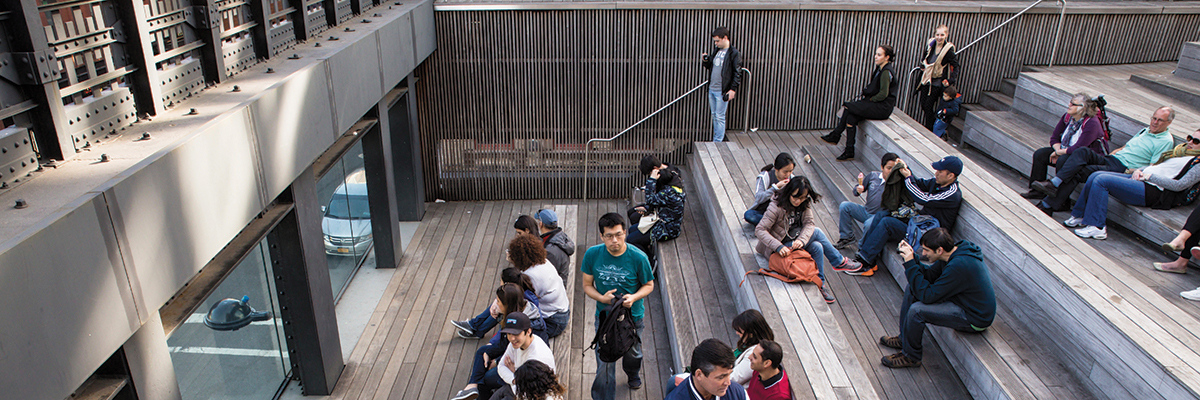Explaining his academic work to the uninitiated, the ecological psychologist Harry Heft divides his scholarship into two parts. The first, he says, is somewhat theoretical and “probably wouldn’t be of interest to a broad audience.” And yet, he says, it leads to the second part of his work, the practical implications of those theories, which should appeal to pretty much everyone: “I don’t know how you can have a sustainable democracy,” he says, “if you don’t have really meaningful public spaces.”
It’s a thought that has preoccupied Heft throughout his time at Denison, where he has spent four decades teaching and writing about environmental psychology, an interdisciplinary field that is concerned with the relationship between the environment and human well-being. He entered the field in the early 1970s when psychologists in large numbers were shifting their attention to the quality of human habitats. Environmental psychology was in some ways a coming-together of the Civil Rights Movement and the environmental movement. In 1980, just four years after Heft arrived in Granville, the sociologist William Whyte released the book and documentary film The Social Life of Small Urban Spaces, which sparked national interest in the use of public space. “The focus here is on creating public spaces whose design characteristics contribute to generating social capital by promoting social interaction,” Heft explains. “Research going back many decades shows that you often get to know people through unplanned encounters, by just bumping into them, in the course of everyday activities. So it’s really about how we can help facilitate connections between people through environmental design.”
For Heft, the need for public spaces that promote social interaction is more vital, and more threatened, than ever. The reasons shouldn’t surprise you—especially if you’re reading this on your phone. “People are more separated now than we ever were before.” Much of Heft’s thinking in recent years has focused on his immediate environment, the Denison campus, where each incoming class of students is more immersed in, and reliant upon, their handheld tech. He mentions walking the hallways 20 years ago to see students interacting between classes; now the students line the walls of those same halls, heads tilted toward their screens. In Granville and elsewhere, college campuses are also more diverse than ever, a benefit that comes with inherent barriers of language and culture—and all the more reason, he says, to consider how public spaces bring people together, and the consequences when they don’t.
The solutions aren’t a mystery: Research shows that anywhere there’s ample room to sit and orient to one another—on chairs, on benches, on low-slung walls—people will gather, both to talk to and watch each other. Heft cites widely popular examples in New York City, most famously blocks in and around Times Square that have been remade simply by closing off traffic lanes and adding benches, tables, and chairs; there’s also the High Line, the walking park and greenway built atop an abandoned rail line on Manhattan’s west side. Closer to home, he cites recent renovation in downtown Columbus, where they’re “rediscovering the river and doing terrific work in this regard.”
Even as he notes that progress, Heft says, “Societally, we still don’t view public spaces as being a high priority. They tend to be treated as empty spaces between buildings rather than spaces that can be used for people to get to know one another.” There are predictable reasons for that—renovating public spaces requires both public funding and long-term thinking to solve a problem that, to many, appears neither obvious nor pressing. It’s with an eye on that long-range thinking that Heft has developed some of his writing and lecturing in the fields of environmental psychology and design.
Which brings us back to the split branches of Heft’s scholarship. The practical design elements of his work stem directly from the theoretical aspect examined in his 2001 book, Ecological Psychology in Context, which has drawn the attention of designers and planners since its publication. He’s set for a sabbatical this fall, with plans to write a follow-up. “I’m hoping to pick up where that one left off, because I think I understand some of those issues in a broader ecological and cultural context,” he says.
Retirement beckons, and while that as-yet-unwritten volume will be a fitting parting gift to his fellow environmental psychologists, Heft has plenty of perspective to offer the rest of us. His point about the fundamental connection between public spaces and a functional democracy may sound hyperbolic, but he insists it’s nothing of the sort. “From my point of view, it’s crucial,” he says. “Public space is for bringing diverse people together, and that creates dialogue, understanding, empathy, feelings of responsibility for others. A reduction of that community investment is sort of a death knell for democracy. It won’t disappear fast, but slowly, it will disappear.”

